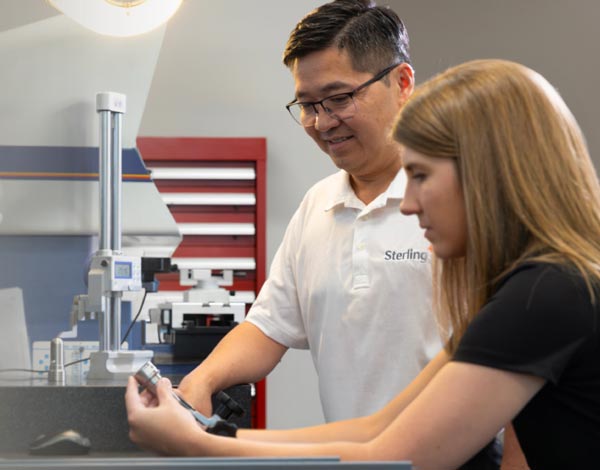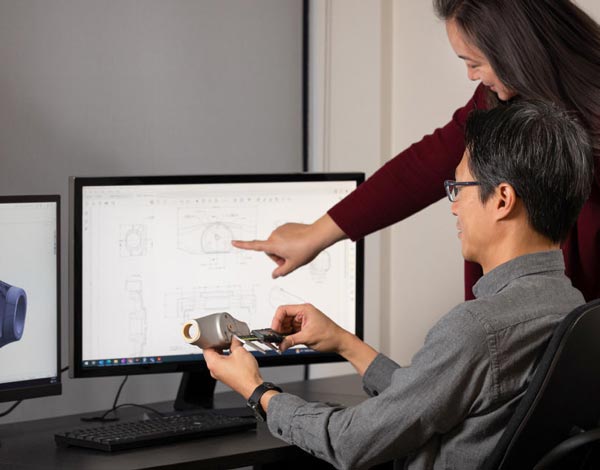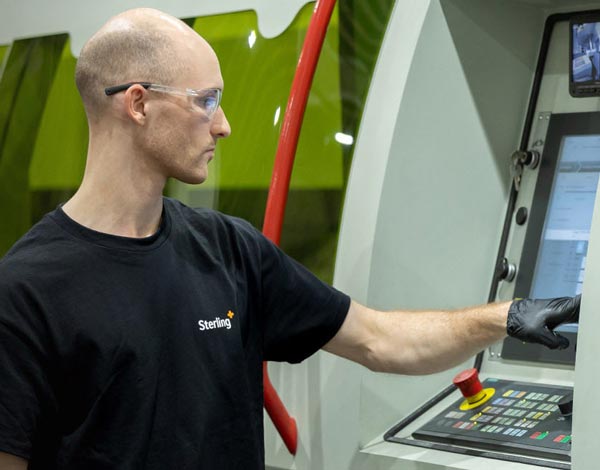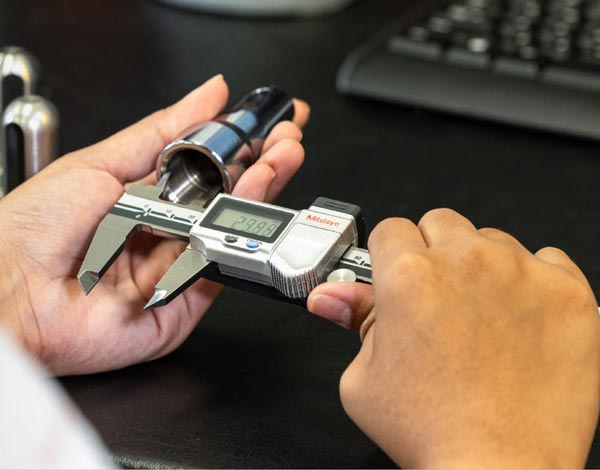Frequently Asked Questions
FAQs
Medical Device Contract Manufacturing Services
Find the answers to some of the most common questions about medical device contract manufacturing. If you have a question that is not covered below, don’t hesitate to ask — we’re happy to share our views and insights on any issue related to Medical Devices: production, design, quality, cost and regulatory compliance.
What does Sterling Industries do?
Sterling Industries is a leading medical device contract manufacturer with manufacturing facilities in the USA and Canada. We provide end-to-end solutions that help our clients — whether Fortune 50 companies, late-stage startups or ‘scale-ups’ — manufacture, assemble, package and deliver their medical devices at scale.
What is Medical Device Contract Manufacturing?
Medical device contract manufacturing is a service where a company is contracted to produce complete medical devices or their components and sub-assemblies on behalf of an Original Equipment Manufacturer (OEM). Sterling Industries is a contract manufacturer that focuses on the production of complete medical devices, including assembly, packaging, and labeling. We also fabricate key components or sub-assemblies for our clients.
What is a Medical Device OEM?
OEM, or Original Equipment Manufacturer, refers to companies that manufacture and assemble complete medical devices to exact client specifications, ensuring these products are finished and ready-to-ship. Medical Device OEMs focus specifically on manufacturing within the strict regulatory and quality frameworks that govern medical device production.
Does Sterling Industries offer design services for Medical Devices?
We specialize in optimizing our clients’ proprietary designs for cost-efficient mass production. Sterling Industries’ Design Transfer process (see below) meticulously captures every nuance of our clients’ original designs. Then, our Design-for-Manufacturing (DFM) engineers (see below) offer manufacturing and assembly optimizations that can improve quality, ensure repeatability, or reduce costs when manufacturing their medical devices at scale. We collaborate with our clients at every step.
How does Sterling manage medical device manufacturing projects?
At Sterling Industries, we take a structured approach to managing medical device manufacturing projects, emphasizing Design Transfer, pricing, and Product Lifecycle Management. This method is designed to to increase efficiency and reduce costs, while enhancing transparency, communication and project oversight. It is a repeatable process for designing any manufacturing solution our clients require, regardless of the product category or underlying technologies.
We have a clear onboarding process that includes a meticulous design transfer process to ensure we capture every detail of our clients’ designs. We also have structured manufacturing and assembly proposals to ensure our clients have complete clarity regarding project expenses and timelines. Lastly, we take a “stage gate” approach to project development, ensuring both parties have aligned and approved on product development, process development, and quality/validation plans before approving production runs.
Everything is documented and measured in our Quality Management System, and once production has begun, we follow a Continuous Improvement philosophy, seeking opportunities to improve repeatability and cost-efficiencies.
Where are Sterling Industries’ manufacturing facilities located?
Sterling currently operates 4 medical device manufacturing facilities in the USA and Canada, covering 180,000 square feet (17,000 square meters). We have flexible, comprehensive manufacturing facilities in both the United States (Kalamazoo, Michigan) and Canada (three location in the Greater Toronto Area).
Learn more at our Facilities page
Why manufacture your medical device in North America?
There are numerous reasons:
- Supply chain security: COVID & geopolitical uncertainty underline just how fragile global supply chains are. By manufacturing your medical devices in North America, at the heart of the world’s largest consumer and healthcare markets, transport and shipping lead times are significantly decreased, both inbound and outbound, minimizing exposure to global risks.
- Regulatory standards: North America has the most stringent standards and regulations for medical devices in the world. At Sterling Industries, our robust Quality and Regulatory practices are part of our core identity.
- Innovation: North America remains at the forefront of global innovation, hosting the world’s top universities, research institutions, and technologies, giving us the ability to remain ahead of the curve and innovative in the medical device sector.
- Skilled labor force: as a center for advanced medical device manufacturing and innovation, North America has nurtured a highly skilled labor force with a track record of quality and compliance.
What are Sterling Industries' medical device manufacturing capabilities?
Sterling Industries has a wide range of advanced medical device manufacturing and assembly capabilities, including:
- ISO Class 7 (10,000) Clean Rooms,
- Electronics assembly and testing,
- advanced injection molding & low-pressure molding (also available in Class 7 Clean Rooms),
- DFA: Design for Assembly and Design for Automation,
- CNC machining,
- laser tube forming & processing
- Metal finishing,
- electronics integration,
- robotic, laser, and ultrasonic welding,
- Serialization and Lot Control,
- automated/robotic high-speed assembly,
- as well as labelling and packaging.
You can find a list of our full capabilities on our manufacturing capabilities page.
What certifications does Sterling hold?
Sterling Industries is ISO 13485:2016 registered, C-TPAT and 21 CFR Part 820 compliant. All our facilities are FDA Registered and Health Canada Registered and maintains state-of-the-art Quality Management Systems.
Is Sterling Industries FDA-registered?
Yes. All Sterling Industries facilities are FDA Registered and its Canadian facilities are also Health Canada Registered in addition.
What is DFM in Medical Device Manufacturing?
DFM stands for Design For Manufacturing, and refers to design refinements that improve the ease, speed, quality, repeatability and/or cost-effectiveness of manufacturing medical devices at scale. Thoughtful DFM decisions can meaningfully impact the profitability and reliability of products. Related terms include DFA (Design For Assembly) or DFMA (Design For Manufacturing and Assembly).
What is a Design Transfer in Contract Manufacturing?
Design Transfer is the process of readying a fully designed and validated medical device for manufacturing production. Every design feature, function and objective is specified; manufacturing processes are then designed and validated to ensure repeatable production that meets all quality and regulatory standards. Design Transfer can refer to either new products or existing products where production will be transferred to a new facility or organization.
What are the key steps in a Medical Device contract manufacturing project?
There are a few key steps in any Medical Device contract manufacturing & assembly project, assuming the client has a validated design and has secured all regulatory approvals:
- Design Transfer: the client communicates all specifications of their design. The contract manufacturer may also provide design & prototyping services to help finalize the product, or Design for Manufacturing (DFM) expertise to optimize for mass production.
- Secure the supply chain: ensure a stable supply of inputs is available to support production.
- Design & validate production processes: the contract manufacturer designs and validates the assembly line and labor processes, as well as quality monitoring standards.
- Quality Management System: all processes and quality standards are documented and entered into an ISO certified Quality Management System.
- Production: with all preparation, testing and validation complete, the first production run begins.
Does Sterling manufacture in the USA?
Sterling has medical device manufacturing facilities in both the United States and Canada, allowing us to take advantage of numerous free trade & tariff agreements and avoid quotas. Strategic configuration of a product’s supply chain, manufacturing and assembly can provide our US-, Canadian- and Internationally-based clients easy, tariff-free access to key markets. Our U.S. headquarters are proudly located in Kalamazoo, Michigan, a medtech hub for manufacturing and innovation.



